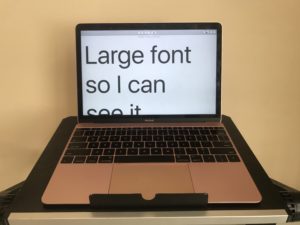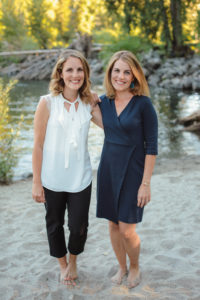I think back to my first school principal 15 years ago, who was extremely kind, and how he probably would have been more than happy to assist me with any accommodations I needed. But I was afraid to ask and too proud to admit when I struggled, which really took a toll on my happiness and even health.
I remember a particularly devastating moment during my first year of teaching. We were doing “student-led” conferences where the 7th grade teachers floated from table to table to meet with students and parents to discuss student progress. I kept waiting for one of my more challenging students to arrive with his parents so that we could discuss some behavioral issues. I never saw the student nor his parents, so I just kept floating from table to table and assumed the family was a no-show. At the end of the evening, our school’s dean said he’d like to talk with me. He told me that RJ and his parents had come to his office to voice a complaint that I had purposely ignored them and walked past the table they were sitting at during the conferences. I was stunned and awkwardly explained to the dean that I hadn’t seen them, which I knew sounded crazy. How could an entire table of people be outside of my line of vision? I asked him why they hadn’t just come up to me, and he said that he even offered to walk them back in to find me but they were too upset. I remember sitting alone in my classroom after the dean left, hot tears of shame and anger slowly trickling down my face as I recounted the evening, wondering if I had unknowingly skipped over any other students due to my lack of sight. I hated that my actions (or lack thereof) were so misunderstood. I later called the parents to apologize, but they seemed to have already pegged me as uncaring and incompetent by that point.
It took me a long time to even tell my team of teachers what had happened, but once I did they made a habit of whispering which students and parents were waiting at tables. But I still dreaded those evenings. Thinking of them now, I wish I had thought to simply ask if I could be seated at a table, or even in my classroom, and have the families come to me instead. Yes, that would have required our team and school to adjust how we were running conferences, but it’s a very reasonable accommodation that would have prevented both misunderstandings and stress.
Today, I am able to ask for what I need more easily. For example, I was struggling with some of our forms, particularly the handwritten ones since my screen-reader does not read handwriting, so I asked my director if one of the admins on our teams could read them to me. She was happy to help and even offered that they type the top portions of my forms.
This isn’t to say I’ve completely figured out how to handle vision loss in the workplace. Far from it. New challenges continue to arise, and I have to figure out how to navigate them.
After my first couple weeks of implementing 504 Plans, for example, I received an e-mail listing some errors in several plans I had finalized and sent to our filing clerk. This might not sound like a very big deal, but these were documents that had already been signed by staff and parents and filed in cumulative student records. In order to correct them, I had to re-upload documents, obtain new signatures and have clerks reprint and refile documents. My oversights cost other employees extra time and effort, which is not even close to the quality work I desire to do. And it sent me immediately into a shame spiral. Fortunately, thanks to Brene Brown and my “Daring Sisters,” I now have some shame-resiliency tools to help me work through blind shame, something I didn’t have in my 20s. Vulnerability is one of these tools, so I was able to share my struggles with a close friend who also has vision loss. She put words to my feelings, saying that my performance didn’t feel consistent with how I would want to perform if I had full sight. I also opened up to a co-worker, who not only offered to start peer-editing my 504 plans but also took the time to empathize and said, “You’re an asset to this team. You bring something that some of us don’t have.” I smiled when she said this because I immediately thought back to the first time I received an e-mail from a teacher and parent of a student with a visual impairment. I couldn’t wait to help a student in an area where I have firsthand experience. But I’ve noticed that it’s not just students with vision loss that I feel grateful to assist. I feel rewarded every time I put an accommodation in place that I know will help a student engage with learning in a way that fosters confidence, regardless of their disability.
My director is working with me to find less cumbersome ways to do my job, including having someone proof my forms for typos. It’s not that I’m not able to spot typos, but I’m not able to “spot check” a document or quickly scan over it like most people can. My screen reader is picky about what types of documents it will read, and it doesn’t always read everything that’s on the screen. Staring at pages and pages of typed documents with intermittent gray boxes causes me a lot of eye fatigue and headaches, so we’re working on ways to streamline the process.
The irony of trying to figure out my own accommodations in order to put accommodations into place for students is not lost on me. I think back to my years as a student and remember teachers telling my parents that I needed to speak up and ask for help, which always confused me because I often didn’t know what I needed.
Now, after years in the classroom, both as a student and a teacher, I’m finding my stride. I’m learning to celebrate the new tasks I have mastered – as small as they might seem at times. I am learning not to compare myself to my co-workers, as they seem to master new things more quickly and with more ease. I’m struggling at times, but I’m not allowing my struggles to shame me.

A friend sent me a framed Brene Brown quote for my birthday that says, “I will not shrink back. I will not puff up. I will stand my sacred ground.” It now hangs over my work desk so that I can glance up at it as a reminder before my meetings. I visualize the name of the student and their needs, and pray for guidance on how to best help them.
I know I may not immediately have all the answers for them, but I at least want to start at a place of empathy and understanding. I’m learning that the more practice I have at standing my own “sacred ground,” the more capable I am of encouraging others to do the same.




